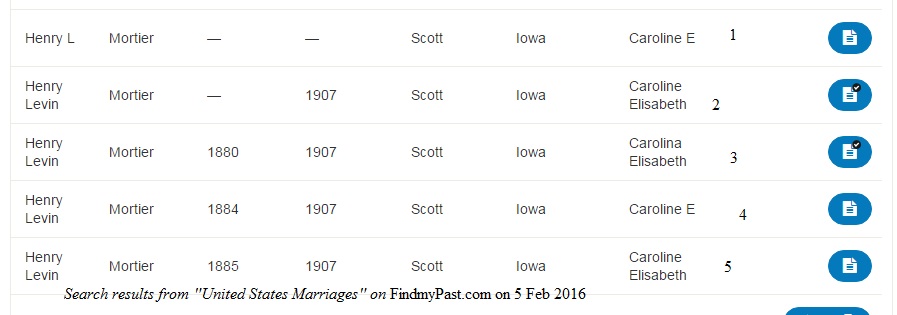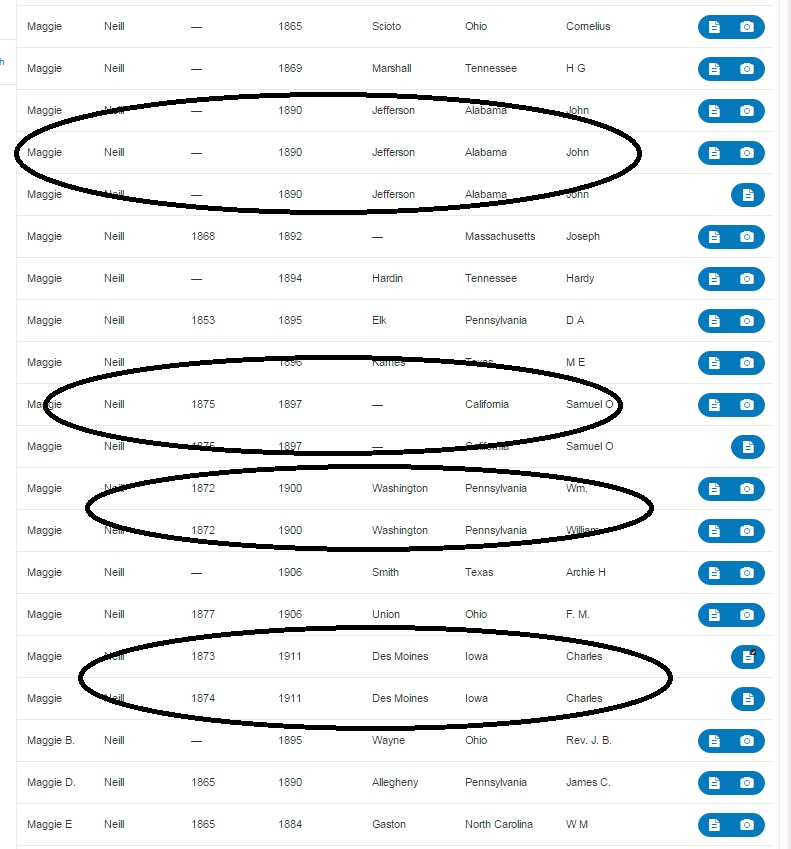[note: all search results displayed in this blog post were obtained on 5 February 2016]
FindMyPast recently announced a database of United States marriages, purporting to eventually be the biggest one available. I’m not certain about that, but it certainly was an interesting one to search.
Five Henrys
There were five separate matches for Henry L. Mortier who married in 1907 in Scott County, Iowa, to Caroline Elizabeth Freund. I am assuming this counts as five separate marriages in FindMyPast‘s marriage count for this database.
Curious where the entries were obtained, I looked at the individual records referenced on FindMyPast. The Family History Library film number is given for each entry as that is where FindMyPast obtains the records. While the film number does at least provide an idea of where the information was obtained, in some cases I can guess the actual volume number from the original records(which I hate to do). The page number I will have to get manually. The plus side of this is that I can’t create a citation to the specific record until I have actually seen it myself. I shouldn’t cite the actual record as I’m not using the actual record when I use the results from this database.
I’m pretty certain that’s not the reason why the volume and page numbers are not included in this database. I don’t think FindMyPast is worried about the completeness of my citations (and to repeat, my citation, if I use this FindMyPast database, should be to this database and not the actual record). However, I should include in my citation that FindMyPast obtained the information from the relevant Family History Library microfilm roll (with additional detail if that can be determined).
In the case of the Mortier-Freund marriage, the entries apparently come from two separate filmings of the marriage record and the marriage returns. The marriage returns are not the same as the marriage record. Without seeing the actual marriage record it is difficult to say just exactly this index entry was extracted from (no image is linked to for any of these entries–they are all text only results).
| # | Film Number | Title | Record Creator | Information given |
| 1 | 002030636 | Marriage record, v. 4 (from p. 292), 1907, v. 5, 1907-1908, v. 6 (to p. 246), 1908-1909 (another filming) | Scott County, Iowa, Clerk of District Court | No parental information given |
| 2 | 002030636 | Marriage record, v. 4 (from p. 292), 1907, v. 5, 1907-1908, v. 6 (to p. 246), 1908-1909 (another filming) | Scott County, Iowa, Clerk of District Court | Name of wife’s parents given only |
| 3 | 001432216 | Marriage certificates and returns Meinert, Herrmann – Mueller, H. 1830-1930 | Scott County, Iowa, Clerk of District Court | Groom and wife’s parents given |
| 4 | 002030636 | Marriage record, v. 4 (from p. 292), 1907, v. 5, 1907-1908, v. 6 (to p. 246), 1908-1909 (another filming) | Scott County, Iowa, Clerk of District Court | Name of groom’s parents only |
| 5 | 1004424 | Marriage record, v. 5-6, 1907-1909 | Scott County, Iowa, Clerk of District Court | Groom and wife’s parents given |
Three Georges
The Mortier-Freund marriage was not the only one listed more than once in the FindMyPast database. There are three entries in the database at FindMyPast for George A. Freund and his bride in 1883. Apparently her name is different on all three entries. Given that her maiden name was Catherine Cawiezell it’s not surprising.
These entries all come from records of the Scott County, Iowa, Clerk of District Court, just different rolls of microfilm or different records on the same roll. In order of search results shown, those rolls of film are:
- Register of marriage records, v. 1, 1880-1890, v. 2, 1890-1891 (another filming)
- Marriage license record, v. 8-9, 1882-1887
- Register of marriage records, v. 1-3, 1880-1903
So that’s three entries for one marriage. Ad again, I can’t tell what volume of records any specific entry was taken.
Multiple Maggies
A search for the marriage of Maggie Neill located several entries that were repeated (only the first screen of results is shown).
The entry in Des Moines County, Iowa, is the one in which I was really interested, but it should be noted that repeat entries also came from other states. The 1911 marriage for Maggie Neill also came from different Des Moines County records of the same marriage.
Some Thoughts
There have to be more marriages entered in the database more than once.
How many marriages are actually in this database more than once I really can’t say. This study is not scientific, but I will say that these are the first three people for whom I chose to look. FamilySearch usually indexes all the marriages they have for a location when they index marriages. This is a good thing as it helps point users towards all of what FamilySearch actually has. Sometimes they may have marriage registers, marriage returns, marriage bonds, and other records resulting from the same marriage. That can result in multiple entries for the same marriage. Those records at FamilySearch are what was used to create the FindMyPast database of United States marriages.
How many unique marriage records FindMyPast actually has is a separate matter from how many entries are in the database.
The FindMyPast press release regarding this database states:
[This database], covering 360 years of marriages from 1650-2010, when complete this landmark collection will contain at least 100 million records and more than 450 million names from 2,800 counties across America. More than 60 per cent[sic] of these marriage records have never before been published online.
I understand where they get 360 years. Simple math. How many states allow complete marriages as recently as 2010 to be entirely public is another matter entirely. That’s governed by state statute.
Why did they start at 1650? No answer from me because I just don’t know.
I am guessing that each of the 100 million records has an average of 4.5 names–giving them a total of 450 million names. How accurate that figure is I really can’t say. I’m just saying where I think they got it.
How many of those 100 million records are unique is a question I can’t answer either. I’ve seen repeats in the database.
The “more than 60 percent of these marriage records have never been published online” is another interesting statement. I’m not certain. The entire marriage record may never have been published online, but I’m wondering if there may have been index entries based on the the marriage that have been published online. 60 percent of 100 million records is 60 million marriages that have never been published online before. That’s a tall order. But the press release does say “marriage records” which is different from “marriage index.”
All of these records from FindMyPast are online at FamilySearch. On FamilySearch, they are separate databases by state. On FindMyPast they are not. You can still search all of FamilySearch‘s marriage databases by using their global search.
I may play with the database at FindMyPast while it is free. Maybe. But after then, I’m probably not adding any subscriptions to my list of regular expenses. This material is easily accessible on FamilySearch.




No responses yet